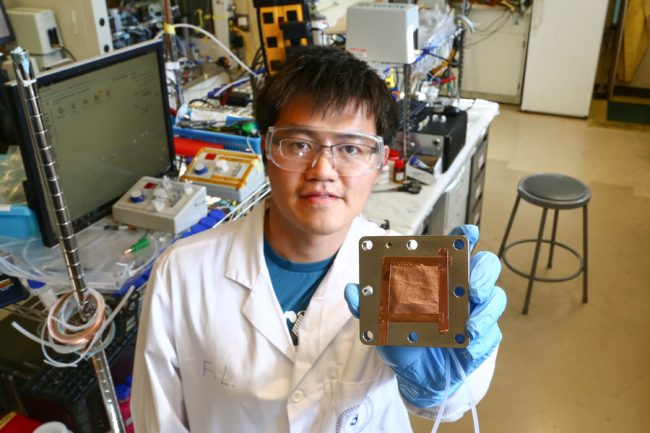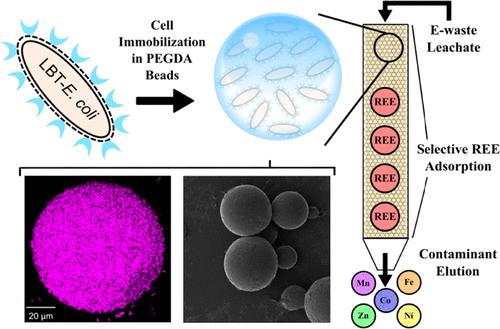(U of T Engineering and Caltech collaborate on pathway to carbon-neutral plastics)
2019/11/20 カナダ・トロント大学

・ トロント大学と米・Caltech が、再生可能エネルギーを利用して CO2 と水を効率的にエチレンに変換するシステムの新設計を開発。
・ 排出 CO2 と余剰な再生可能エネルギーの貯蔵・利用を拡充しながら、有用な化学物質を作るカーボンニュートラルな手法を提供する。
・ 2018 年に銅ベース触媒の課題を解決し、CO2 の電気的還元反応でエチレンを記録的な高効率で生成する選択性と安定性に優れたシステムを開発したが、今回、システム性能の向上と運転コストの低減に向けて同触媒をさらに改良。
・ CO2 からエチレンへの還元反応における課題は、エチレンに変換される CO2 の成分の大部分が特に炭酸塩等の副生物として電解槽の溶液に溶け込むため、分離と精製のコストがかかること。
・ 今回、理論計算と実験を通して多種類のアルキルピリジニウム分子を調査し、そのうちの一種類の薄膜層を銅触媒の表面に添加するとエチレン生成反応の選択性が飛躍的に向上した。また、反応の pH が塩基性から中和性となり、低い pH を維持するための化学物質が不要に。これによりコストが低減し、炭酸塩として CO2 を損失することがなくなった。
・ さらに、改良した同触媒はより長寿命で、約 200 時間安定性を維持。また、触媒表面積を 5 倍拡大することで、産業レベルへのスケールアップに向けて解決すべき課題を認識できた。
・ 同システムプロトタイプでは商用化への道のりは長いものの、その全体的なコンセプトは、化石燃料を使用しないエチレンベースのプラスチック製造や、CO2 のフィードストック化による炭素捕獲への投資のインセンティブ付加等、持続可能性の推進の課題に対処するものと考える。
URL: https://news.engineering.utoronto.ca/u-of-t-engineering-and-caltech-collaborate-onpathway-to-carbon-neutral-plastics/
(関連情報)
Nauture 掲載論文(アブストラクトのみ:全文は有料)
Molecular tuning of CO2-to-ethylene conversion
URL: https://www.nature.com/articles/s41586-019-1782-2
<NEDO海外技術情報より>
Abstract
The electrocatalytic reduction of carbon dioxide, powered by renewable electricity, to produce valuable fuels and feedstocks provides a sustainable and carbon-neutral approach to the storage of energy produced by intermittent renewable sources1. However, the highly selective generation of economically desirable products such as ethylene from the carbon dioxide reduction reaction (CO2RR) remains a challenge2. Tuning the stabilities of intermediates to favour a desired reaction pathway can improve selectivity3,4,5, and this has recently been explored for the reaction on copper by controlling morphology6, grain boundaries7, facets8, oxidation state9 and dopants10. Unfortunately, the Faradaic efficiency for ethylene is still low in neutral media (60 per cent at a partial current density of 7 milliamperes per square centimetre in the best catalyst reported so far9), resulting in a low energy efficiency. Here we present a molecular tuning strategy—the functionalization of the surface of electrocatalysts with organic molecules—that stabilizes intermediates for more selective CO2RR to ethylene. Using electrochemical, operando/in situ spectroscopic and computational studies, we investigate the influence of a library of molecules, derived by electro-dimerization of arylpyridiniums11, adsorbed on copper. We find that the adhered molecules improve the stabilization of an ‘atop-bound’ CO intermediate (that is, an intermediate bound to a single copper atom), thereby favouring further reduction to ethylene. As a result of this strategy, we report the CO2RR to ethylene with a Faradaic efficiency of 72 per cent at a partial current density of 230 milliamperes per square centimetre in a liquid-electrolyte flow cell in a neutral medium. We report stable ethylene electrosynthesis for 190 hours in a system based on a membrane-electrode assembly that provides a full-cell energy efficiency of 20 per cent. We anticipate that this may be generalized to enable molecular strategies to complement heterogeneous catalysts by stabilizing intermediates through local molecular tuning.



